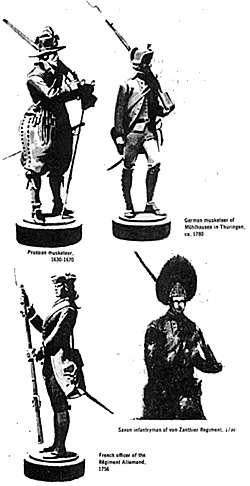
Christopher Weikhmann's
Appropriately enough, the earliest of "modern" war games was a development of chess. Equally appropriately, it was invented by a Prussian, Christopher Weikhmann, at Ulm, in 1664. This game used thirty pieces for each opponent, a king, a colonel, a marshal, a captain, knights, chancellors, heralds, chaplains, couriers, adjutants, bodyguards, halberdiers, and private soldiers (or pawns). There were 14 kinds of fixed moves, similar to the ones in chess. in essence, it was chess, but elaborated in the first of many attempts to add to the realism and the complexity of the game. Here the long striving for the most realistic game possible began, long after the first relatively simple chess games were played. It still goes on.
Louis XV's card game
During Louis XV's long reign, in France, from 1710 to 1774, an anonymous war game played with cards was developed. Used to train military students in basic principles, this game eventually gave rise to a similar one in a different field, Le Jeu de la Fortification. In an age when siege operations against strongly built works were almost the whole of war, and when fluid maneuver was rare, this game recalls the contemporary mock battles of Corporal Trim and Uncle Toby,* in Laurence Steme's Tristram Shandy, most of which were concerned with the most elaborate engineering projects designed to overcome the defense of fortifications.
Helwig's
The later years of the l8th century found an increase in the mathematical approach to warfare, as embodied in the thenpopular term, "military mathematics." Von der Goltz said: "A true strategist of that epoch did not know how to lead a corporal's guard across a ditch without a table of logarithms." Helwig's War Chess, an elaboration of standard chess, was hedged about with such mathematical rules. Played on a modified chess board with 1,666 small squares, tinted to show differences in terrain, it applied the standard mathematical approaches to the reduction of a fortress, instead of a king. Helwig, a master of pages of the Court of Brunswick, developed the game to train his young charges for their future careers as officers in the army.
George Yinturinus's
Vinturinus, a famous military writer and tactician of Schleswig, developed his chess-like game for a board or chart of 3,600 squares, with troops represented by chess-like pieces. Some effort was made to show terrain features in this game, also, but the attempt. was primitive. The book in which the game was described devoted 60 pages to complex rules governing the movement of troops, combat conditions, supply, and the like. This complexity took the game wholly out ofthe class ofamusement, except for the most serious members of the military profession. Von der Goltz, who was contemptuous of everything in the period, called it "a bad product of the refined military education of the time."
This is the first of a series of re-prints from a booklet THE GAME OF WAR, pubulished some 15 years ago by TECHNICAL OPERATIONS INCORPORATED of Burlington, Massachusetts, U.S.A., who have kindly given permission for its reproduction. There will be another chapter next month.
Back to Table of Contents -- Wargamer's Newsletter # 155
To Wargamer's Newsletter List of Issues
To MagWeb Master Magazine List
© Copyright 1975 by Donald Featherstone.
This article appears in MagWeb (Magazine Web) on the Internet World Wide Web.
Other military history articles and gaming articles are available at http://www.magweb.com